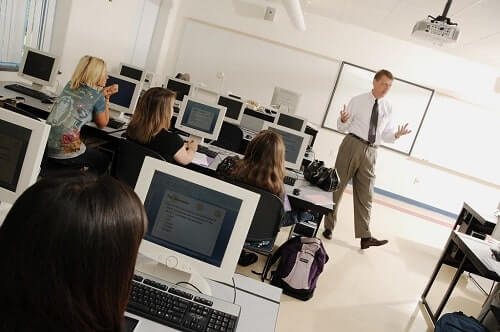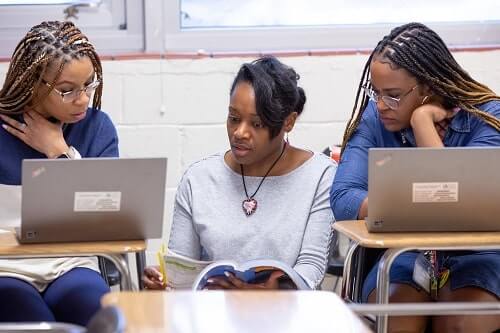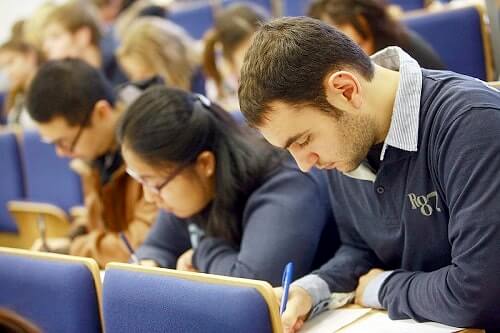The use of computers, laptops and tablet devices is creating a remarkable new set of conundrums for teachers, students and parents. In the ‘digital revolution’ the question is, what do we let go of, and what do we retain, in order to ensure there is continuity in learning?
In education, change is important and can lead to adaptive behaviours, but sometimes change does not imply progress. The key issue is whether or not change improves how we teach, how we understand student learning and how robust students become in their capacity to engage, understand, critique, evaluate and solve problems.
Technology raises significant opportunities and also significant challenges. For example, technology helps in the presentation of ideas and improves access to information. Technology also allows people to feel connected when distant, to reach across natural borders and to find new ways of viewing issues.

When using technology in the classroom, there has been a change in how teachers and students engage with content, ideas, challenges and curricula. Teachers are expected to use technology in classrooms to create and deliver unique teaching and learning experiences. It is an expectation that they will also encourage the appropriate use of technology such that students can navigate their way through distraction. This requires that students use technology regularly throughout lessons.
In schools, technology in classrooms are often used to create detailed presentations of syllabus content, with occasional links to YouTube videos or relevant websites. Students are either expected to type the notes they see projected – or to hand write the content in a notebook. Generally though, the skill of handwriting is on the decline. After all, the slides can be sent to all students by email, or the content can be downloaded and converted to word documents from the school intranet.
Teachers also encourage students to provide responses that are word processed and delivered in ‘soft copy’, or printed in hard copy, rather than asking for handwritten work. Word processing helps in presentation and also in marking, but the use of word processing can also mask spelling issues as autocorrect options can be applied.
And so arise interesting issues about handwriting. In a period of change, how can we manage the retention of traditional skills and the need for literacy whilst embracing new skills that can undermine students’ abilities?

Assessments are the most overt issue connected to the skill of handwriting particularly, and writing more generally. Currently in schools, while the use of technology in classrooms is becoming more prominent, the overwhelming proportion of examination-based assessment involves writing by hand. Exams are always time limited and therefore require students to hand write answers in a fast and efficient manner. Exams themselves also tend to create anxiety or nervousness. For students, hand writing is often performed while they are tense and under time pressure.
Exams are intended to test a cohort of students. There are questions that require higher order thinking skills that can only be demonstrated by student responses that are cohesive, detailed and demonstrate a capacity to think critically. In order to present higher order responses, there needs to be structured, well-synthesised answers.
Students report that, under time pressure, it is hard to write exam responses without their hands cramping or feeling sore. Moreover, since most student experiences of technology allow for editing and ready change, students find that when they hand write they tend to cross out quite a bit of written text, use arrows to indicate the order in which text should be read and feel stuck if they find they have started an answer and would then like to re-sequence their response.
It is be clear that attention needs to be brought to the issue of handwriting with respect to examinations and written assessments

As a skill, handwriting should not be lost. There are numerous reasons for this. Handwriting provides the capacity for students to pause, reflect and consider their words prior to marking a page. Hand writing a response that needs to develop an argument, or present a case, requires a level of planning and structure as well as attention to order.
When drafting hand written responses, students tend to find that their thinking is in advance of their capacity to write. This is extremely important to note, as hand writing can be seen as laborious when thinking runs ahead of the capacity to record ideas.
It should therefore be clear that handwriting affords opportunities for learning that may be lost when using technology. Well ordered responses to problems require forethought, planning and ‘big picture’ thinking. In this regard, handwritten responses can be daunting and students may avoid them.
It may be time for educators to recast assessments such that there is an integration of both worlds that students occupy – the digital and the traditional. This would require assessment that allows for the use of technology as well as a capacity to provide written responses. In this way, different skills and abilities could be assessed.
A hybrid model of examination-based assessment does require schools and educational authorities to ask what the point of technology is and how it should be used in order to create thinking, engaged, adaptive students who live in a hybrid world.
READ MORE: Hybrid education




